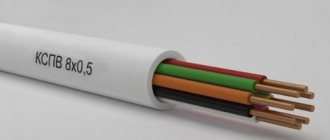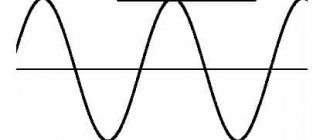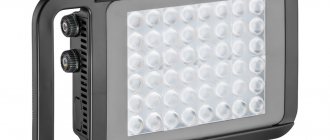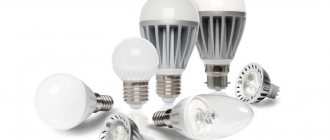The principle of operation of incandescent lamps under load.
The filament of an incandescent lamp experiences the greatest load at the moment it is turned on. This is due to the fact that the light bulb coil in a cold state has a resistance tens of times less than when it is hot.
Experimental testing of the most common incandescent electric lamps with a power of 25, 40, 60, 75, 100 W shows that their cold resistance is 155.5; 103.5; 61.5; 51.5; 40 Ohm, and in the working one - 1936; 1210; 815; 650; 490 Ohms, respectively. Then the ratio of “hot” to “cold” resistance is 12.45; 11.7; 13.25; 12.62; 12.4, and on average it is 12.5. These indicators are taken from the reference book. But out of curiosity, our electricians in Korolev carried out such experimental measurements and came up with the same numbers.
As a result, the incandescent lamp, when turned on, operates under extreme conditions at currents that exceed the rated one. This leads to a reduction in the life of incandescent light bulbs, accelerated wear of the filament and premature failure, especially when the voltage in the supply network is exceeded. The latter circumstance, with prolonged excess voltage relative to the nominal one, leads to a sharp reduction in the service life of the lamp. As a result, the next time you press the switch, the light bulb will burn out, and the machine in the panel may even turn off. Are you wondering what to do if the lights go out and the apartment loses power?
The best price/quality LED light bulbs for the home
OSRAM Led Star Classic 827 FR, E27, A60, 9.5 W
Many are still convinced that the products of world leaders (OSRAM, Philips) are very expensive. Today this is not entirely true: look, for example, at the Star Classic lamp series from OSRAM. You can buy one for less than 100 rubles, with a power of 9.5 W and a service life of up to 15,000 hours. Warm white light is suitable for both the bedroom and rooms such as a corridor or office.
ERA B0020629, E27, P45, 6 W
An inexpensive LED light bulb from ERA can last 25,000 hours. Its power is only 6 W, which corresponds to 40 W of an incandescent lamp. For the most part, it is convenient for installation in the toilet, since, for example, when visiting this room at night, it does not hurt the eyes too much. It can also be screwed in to illuminate closets, closets and other rooms where people are relatively rare.
Its average price in stores is 50 - 60 rubles. Over a long service life, it will pay for its price in full. It fits a regular cartridge, which “accepts” bases with a diameter of 27 mm.
Lightstar E27 G95 13W 4200K
The 13-watt balloon-shaped LED bulb is suitable for illuminating a room in a house up to 20 m2. The lamp is made in Italy, which the manufacturer claims, speaking about its high quality. The frosted bulb has a pleasant warm light (as close as possible to daylight). One of its main advantages is the ability to connect a dimmer. A dimmer is a regulator of the power of a light bulb in a home lighting system, which allows you to change the brightness to suit your needs.
Lightstar products appear from time to time in television programs such as “Housing Question” and “Repair School”. The lamp life is 20,000 hours - not the longest for LED models, but it pays for its cost.
REV 32421 8, E27, 50W
A powerful German-made LED lamp of 50 W (equivalent to an incandescent lamp of 400 W) is intended for lighting repair boxes or a small home workshop. Fits standard cartridge. The bulb produces a cool, rich white light.
The light bulb can serve its owner up to 30,000 hours - three and a half years of continuous operation (and if you take into account that it does not work all the time, the service life doubles). The cost of the lamp is, of course, considerable, but you have to pay for German quality.
The service life of an incandescent lamp is highly dependent on operating conditions.
The service life of a conventional incandescent light bulb depends on:
- on the quality of wire switching;
- on the quality of installation and connection of the chandelier;
- on the build quality of the lamp;
- on the stability of the rated voltage;
- from the presence or absence of mechanical impacts on the lamp, shocks, shocks, vibrations;
- on ambient temperature and humidity;
- on the type of switch used and the rate of increase in current when power is applied.
Advantages and disadvantages of devices
Primitive lamps, however, are endowed with certain advantages, including:
- They do not require special disposal.
- Able to function at low temperatures.
- They are not afraid of high humidity.
- They can withstand power surges.
- Operate over a wide temperature range.
- There are no negative consequences when breaking.
- Affordable price.
- Compactness.
- No additional warm-up time is required.
- Can be used for dimming.
- The spectrum is ideally perceived by the human eye. Its type belongs to the continuous category.
- Huge voltage spread.
- There is no need for an additional ballast.
- No hum.
- Polarity insensitive.
- Does not create radio interference.
- Low levels of ultraviolet radiation.
There are also disadvantages, and they are worth mentioning:
- too much electricity consumption;
- low color rendering index;
- additional electricity is required for heating;
- insignificant working resource;
- high sensitivity to mechanical stress;
- the spectrum contains only red and yellow colors;
- slight shaking leads to damage to the spiral;
- a glass flask may break if dropped;
- a huge amount of heat is generated;
- fire hazard;
- risk of explosion, which may cause injury.
How to increase the life of an incandescent lamp.
In order to extend the resource and operational life, it is necessary to understand why incandescent electric lamps burn out. When a light bulb operates for a long time, its filament gradually evaporates under the influence of high heating temperatures, decreases in diameter and breaks (burns out).
The higher the heating temperature of the filament, the more light it emits. In this case, the filament evaporation process becomes more intense and the lamp service life is reduced. Therefore, for incandescent lamps, the filament temperature is set at a temperature that ensures the required light output of the lamp and a certain duration of its service.
You can increase the service life of incandescent lamps by including soft starters in the circuit, which will smooth out the load that occurs at the start of a cold lamp. To clarify possible ways to extend the operation of lamps, consult a specialist. For example, our electrician in Mytishchi, at the entrance of an apartment building, assembled a staircase lighting circuit, calculating the optimal operating life of the lamps. Our masters who provide electrician services in Pushkino have the same experience.
Pros and cons of incandescent lamps
Incandescent lighting devices have their own characteristics. The positive ones include:
- instant ignition of the spiral;
- environmental safety;
- small sizes;
- reasonable price;
- the ability to create devices of different power and operating voltage of both alternating and direct current;
- versatility of application.
To the negative:
- low efficiency of incandescent lamp;
- sensitivity to voltage surges that reduce service life;
- short working hours, not exceeding 1000;
- fire hazard of lamps due to strong heating of the bulb;
- fragility of the structure.
The average lifespan of an incandescent lamp is 1000 hours.
The average burning time of an incandescent lamp at the design voltage does not exceed 1000 hours. After 750 hours of burning, the luminous flux decreases by an average of 15%.
Incandescent lamps are very sensitive to even relatively small increases in voltage: with a voltage increase of just 6%, the service life is halved. For this reason, incandescent lamps that illuminate staircases burn out quite often, since at night the electrical network is lightly loaded and the voltage is increased.
Principle of operation
The source works by emitting wave radiation due to electronic molecular excitation and atoms, as well as due to thermal vibration of the filament molecular nucleus. As the temperature of the filament increases, the translational, vibrational and rotational energy of charged particles increases. As a result, the flux of radiation with average photon energy increases. The radiative wavelength moves into the short-wave infrared and long-wave visible regions. In the future, the body temperature will increase, providing energy that is sufficient to excite molecules and atoms and produce short-wave visible radiation. Therefore, the main factor that determines density with radiation wavelength is temperature.
You may be interested in Features of light bulb sockets
Operating principle of incandescent lamps
Operational service life of energy-saving LED lamps.
LED lamps do not have an incandescent filament and are designed completely differently than ordinary Ilyich light bulbs. In connection with a fundamentally new manufacturing technology, it can be noted that their main advantage is the longest service life. Manufacturers claim a nominal life of up to 50,000 hours! Compared to incandescent light bulbs, this is 50 times more. If we recalculate these indicators based on the mode of use in normal home conditions, then we can say that an LED light bulb will last 15 years. And this, you see, is a significant period. During this time, you can forget the simplest procedure for replacing a light bulb in home lamps.
Unfortunately, in practice, the service life of LED lamps varies depending on the manufacturer around the figure of 5 years, which, of course, still exceeds the service life of conventional incandescent light bulbs.
The guaranteed service life of energy-saving fluorescent lamps is up to 20,000 hours.
In terms of production technology, fluorescent lamps also differ significantly from incandescent lamps. Inside the lamps there is an inert gas and mercury vapor. An electric current passes through the lamp, resulting in ultraviolet (UV) radiation. The internal surfaces of the lamp are coated with a special substance - phosphor. It absorbs ultraviolet radiation and converts it into visible light. The so-called luminescence phenomenon occurs.
The service life of fluorescent fluorescent lamps ranges from 2,000 to 20,000 hours. Manufacturers stipulate ideal operating conditions, under which it will be possible to use fluorescent lamps for as long as possible. First of all, there should be no more than 5 on/off switches. Therefore, these fluorescent lamps are not suitable for use in areas where switches are frequently flicked, or in conjunction with motion sensors. In addition, there should be no voltage surges.
Unfortunately, the actual service life of fluorescent lamps does not always live up to the declared ones due to the fact that there are a lot of low-quality light bulbs on sale, mainly made in China.
Service life of halogen lamps.
Halogen lamps are similar in structure to incandescent lamps. They also have a spiral. But their flask is filled with a special, so-called buffer gas: halogen vapor (bromine or iodine). Halogen vapors increase the life of the light bulb to 2,000 - 4,000 hours. Moreover, the smaller the halogen bulb, the longer it will last.
When using soft starters, the operating life of halogen light bulbs can be increased to 8,000 - 12,000 hours. If we compare halogen lamps with LED lamps, the former, of course, are significantly inferior to the latter. But at the same time, they can be freely used in conjunction with a dimmer or diode switch, just like incandescent light bulbs.
If the material in this article was interesting and useful for you, share it with your friends on social networks. Perhaps this information will be very useful to someone. Sincerely, Royal Electrician in Shchelkovo.
The best fluorescent light bulbs for the home based on price/quality criteria
VOLPE E14 T2 15W 6400K
This is a budget 15 W fluorescent model, which corresponds to a 75 W incandescent lamp. A luminous flux of 860 lm is enough to illuminate a hallway in the hallway, a barn or a garage. It can last up to 10,000 hours, which is about a year and a half.
This lamp is suitable for lamps with an E14 socket - this is a reduced diameter of the base, which is suitable for many chandeliers and lamps. Therefore, if there are 2 - 3 light bulbs in a chandelier, it can provide high-quality lighting for a living room or bedroom.
TDM ELECTRIC E27 T2 20 W 6500K
The domestically produced lamp is equipped with a standard E27 base (base diameter 27 mm), so it is suitable for most sockets. Its power is 20 W, which corresponds to 100 W of an incandescent lamp - this, so to speak, is the standard for a room with an area of up to 15 m2. The average service life of the device under normal conditions is 10,000 hours.
Camelion 10407, E27, 45 W
The 45 W bulb has a luminous flux of 2745 lm - this is enough to illuminate a large room, office or classroom at school. It corresponds to a 225 W incandescent lamp.
The Camelion lamp operates normally in the network voltage range from 207 to 244 V. Therefore, if you do not have frequent power surges, then this model is for you. Its service life is 10,000 hours - however, like most luminescent models.











